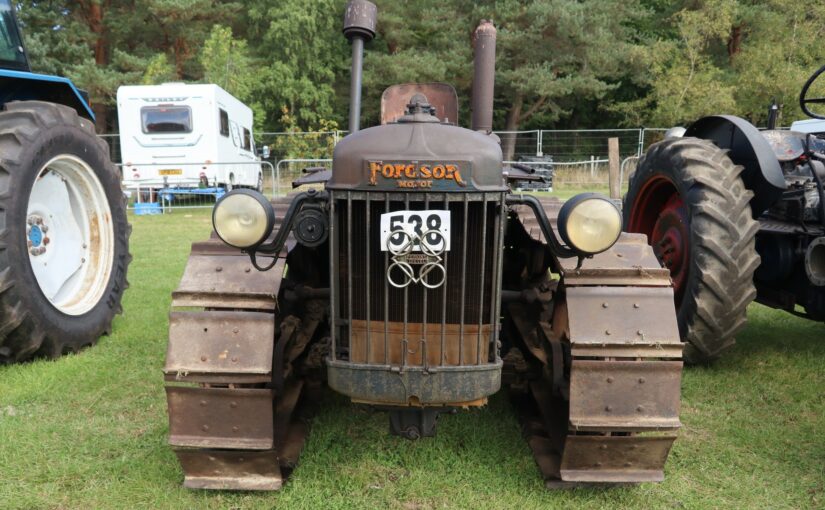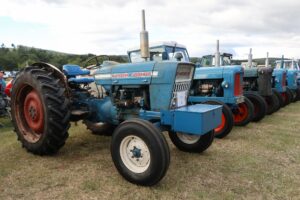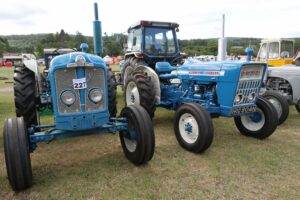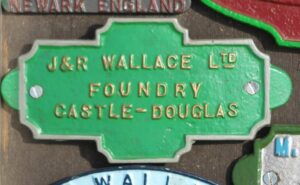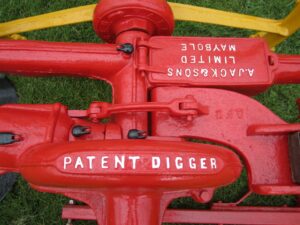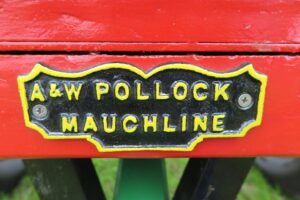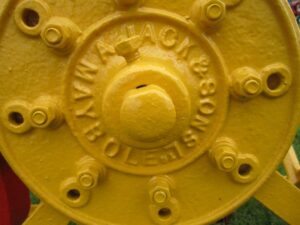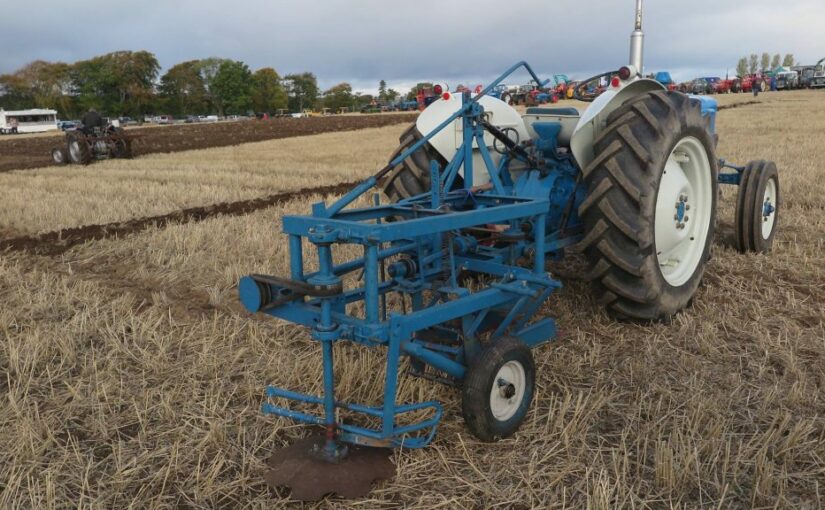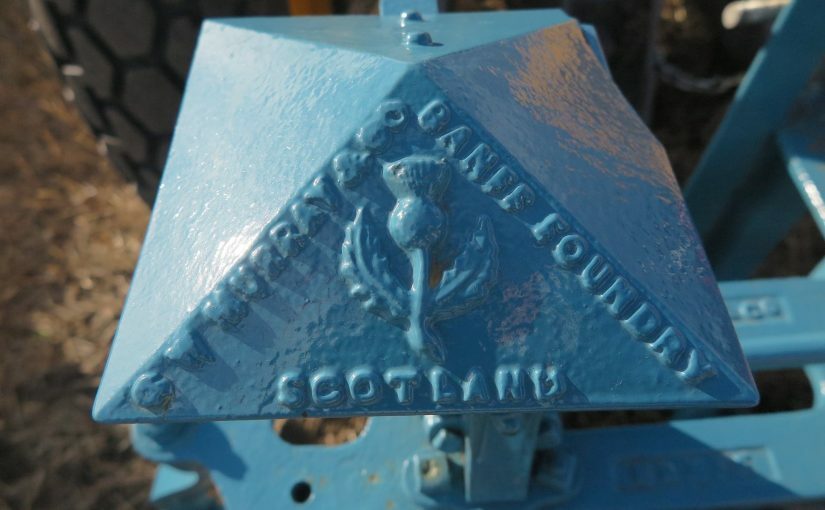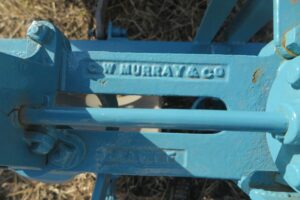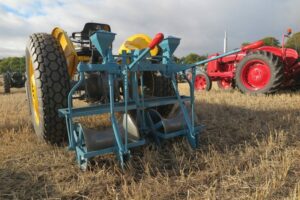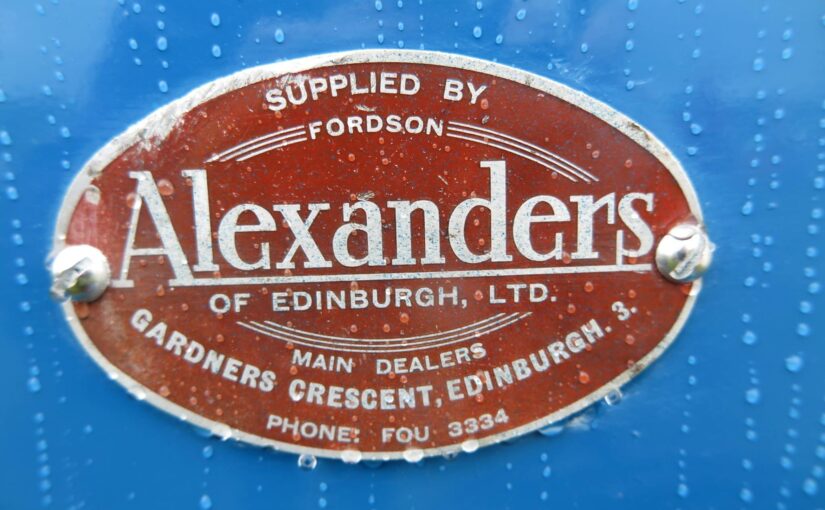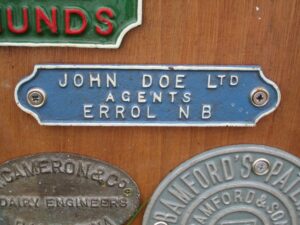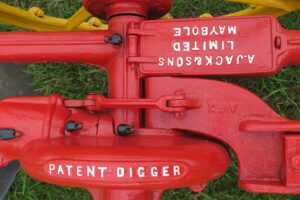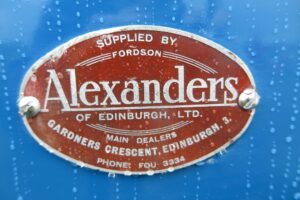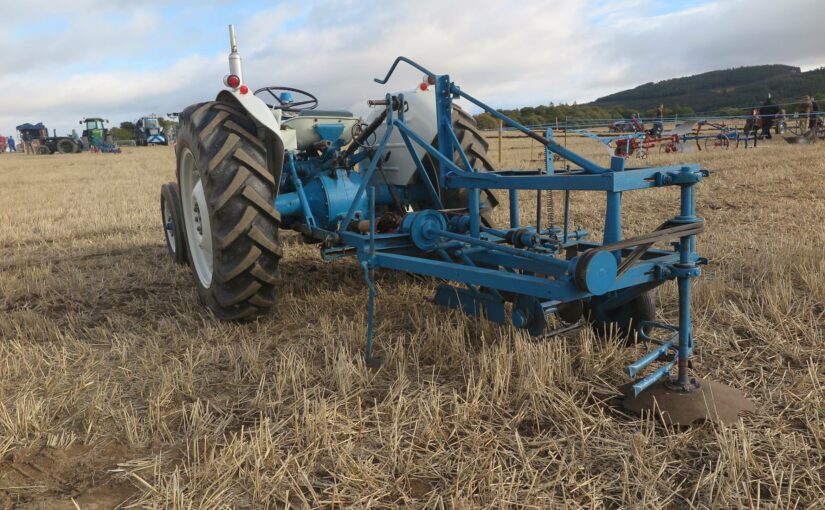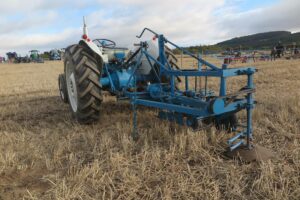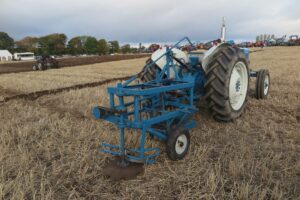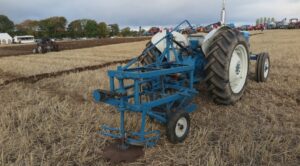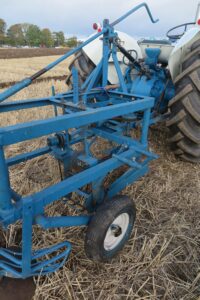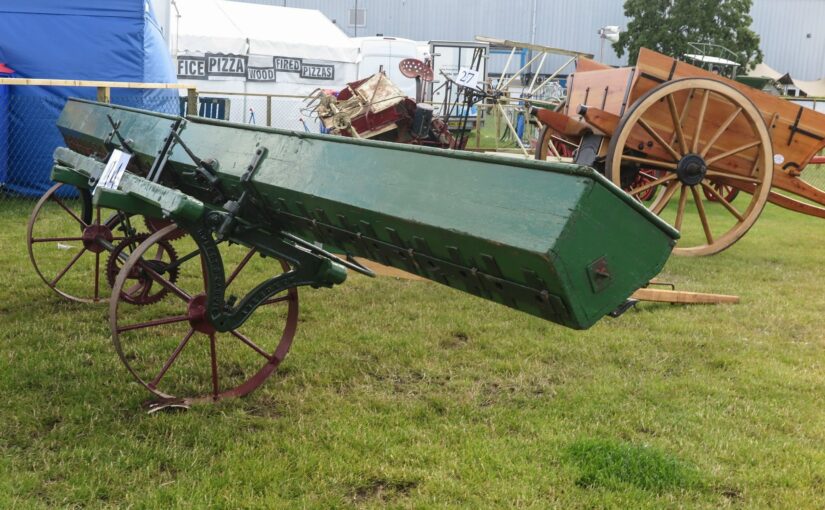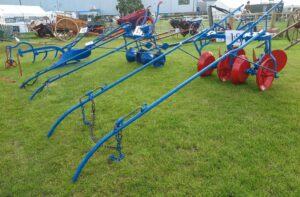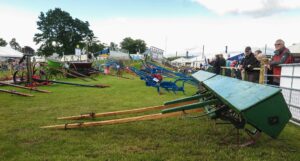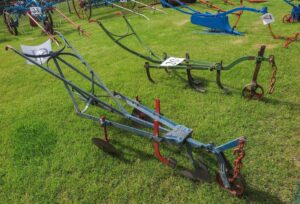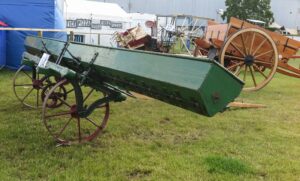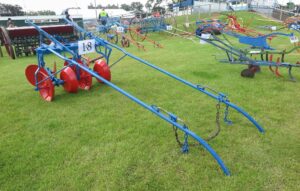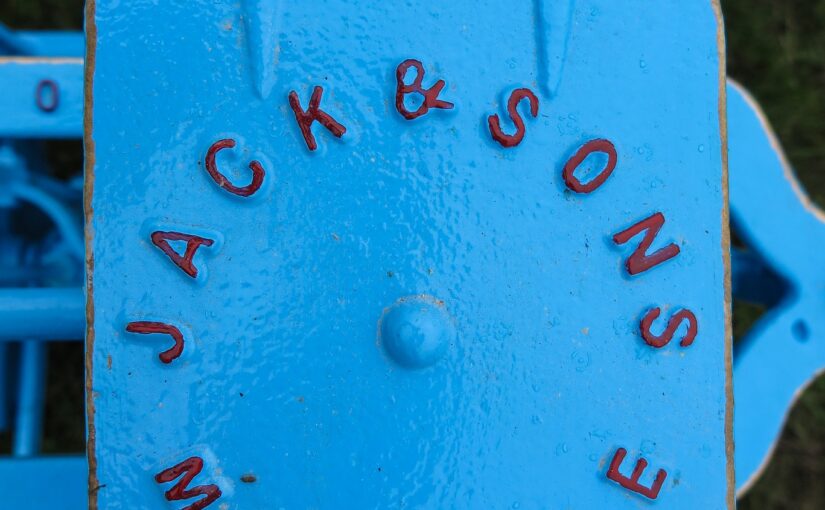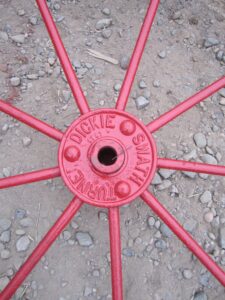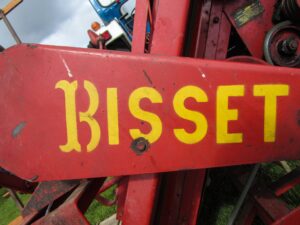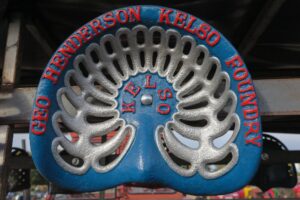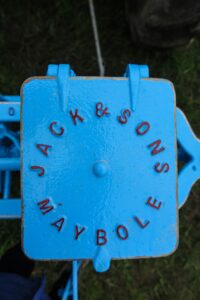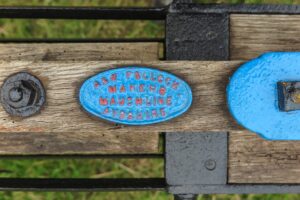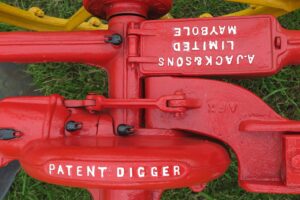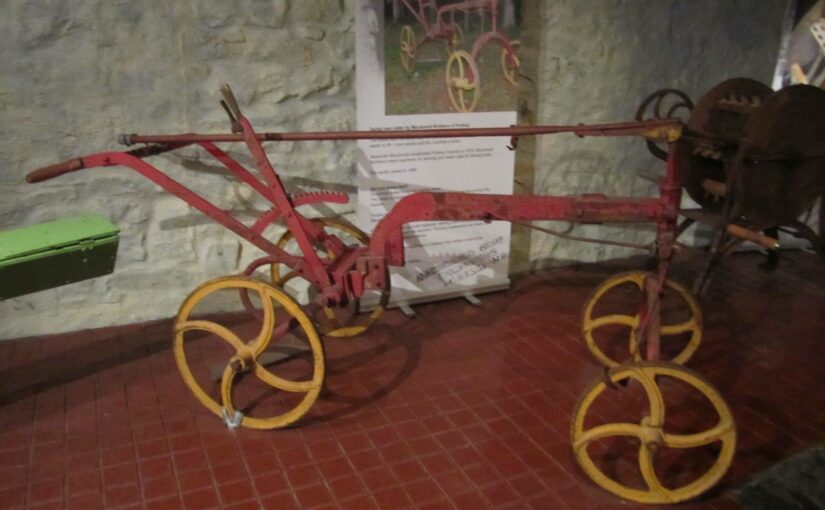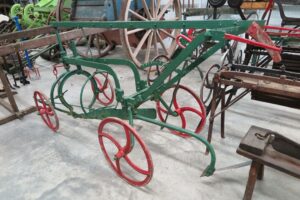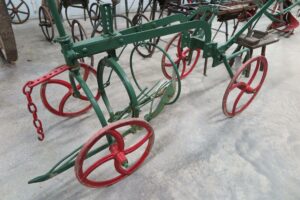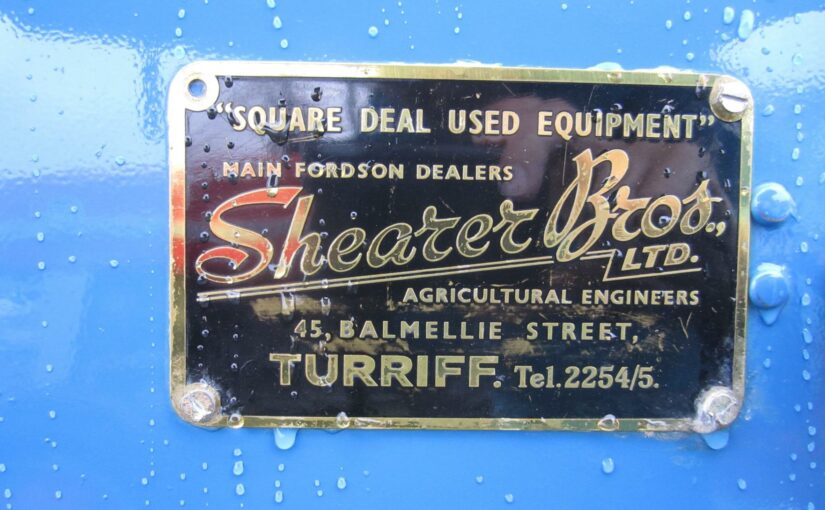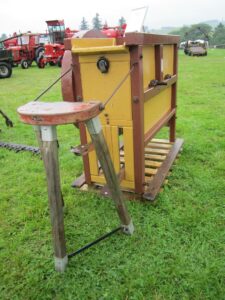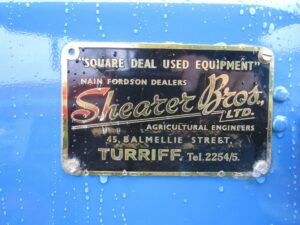What implements and machines were to be found on farms in eastern Scotland in 1932?
While the new implements machines that were available to the Scottish farmer and agriculturist were recorded the Scottish farming press and could be seen at the Highland Show, the older and more generally used ones were recorded in the displenishing sale notices. These provided an inventory of the stock, crop and implements for sale when a tenant was giving up their tenancy, leaving the farm, or other reasons.
These notices provide a record of the implements and machines that were being used on a farm, the types of activities undertaken, and how mechanisation was being embraced.
By 1932 farms in central Scotland were using implements made by both local makers and north American ones, through the well-known maker of Massey-Harris. These included ploughs such as the Dux and the 110a plough, and harvesting machinery such as the McCormick binder and the McCormick mower. Key makes of implements were recorded, as in the sale notices for Ballomill and Woodhead (for example the steelyard of White of Auchtermuchty), Killearis (hay mower of Bisset of Blairgowrie). Dargill, Crieff had a large number of implements and machines from key makers such as Wood of London (also of north America), Sellar of Huntly, Albion of Leigh, Lancashire, Jack of Maybole, and Wallace of Glasgow,
Few of the farms were using tractor power. Corrielea, Bankfoot, had made the transition with a Fordson tractor from 1931 which was accompanied with a double furrow Oliver plough and brake harrows). Its other implements and amchiens would likely have been worked by horse.
Ballomill, Ladybank (Dundee courier, 14 October 1932)
3 coup carts, 2 corn carts (one on wheels), Massey-Harris binder, mower, horse rake, rick lifter, hay collector, manure distributor, potato digger, potato dresser, turnip sower, turnip sower, turnip cutter, roller, cake breaker, 1 110a ploughs, drill plough, furring up plough, Dux plough, 2 diamond, Parmitter, chain, circle and drill harrows, drill grubber, cultivator, drill scarifier, bench and vice, 2 cattle troughs, sheep dipper, sheep troughs, nets, stobs, flakes, 3 ladders, steelyard (White), wheelbarrow, sack barrow, 2 small poultry houses, potato sculls, barn, stable and dairy utensils, 2 sets cart and plough harness, set pony harness, B. L. gun, also quantity surplus household furniture.
Woodhead, Newburgh (Dundee courier, 14 October 1932)
2 coup carts, corn cart, Dux plough, 40 X plough, drill plough, diamond drill, common and brake harrows, cultivator, Hunter hoe, Hoosier sowing machine, McCormick binder, McCormick mower, horse rake, hay collector, wooden roller, turnip sower, sheep turnip cutter, barn fanner, steelyard (White), sack barrow, cake breaker, wheelbarrow, swingletrees, ladders, forks, graips, shovels, drag rake, hoes, barn and stable utensils, stack, cart, and 2 binder covers, cattle bands, 2 rolls 6ft poultry netting, 1 roll 3ft poultry netting, 12 hen coops, 6 rolls rabbit netting, sheep netting, dairy utensils, harness for 1 pair horses, 200 net stakes (new), 6 sheep turnip troughs (new), wheelbarrow (new), handbarrow (new), scrap iron &c.
Kinnearis, near Letham (Dundee courier, 14 October 1932)
3 coup carts (with tops), 3 lying carts (with frames), water cart, cattle float, 3 swing ploughs, 3 110a ploughs, 2 drill ploughs, 3 brakes, iron harrows, drag harrow, chain harrows, circular harrows, long harrows, drill grubber, 2 land grubbers, 2 turnip scrapers, long marker, broadcast sowing machine, 2 turnip sowers, scarifier, manure machine, cultivator, double roller, potato digger, hay mower (Bisset), horse rake, hay gatherer, 2 Bisset binders, Massey-Harris binder, potato hopper and 2 harps, potato barrow, 2 wheelbarrows, turnip cutter, sheep turnip breaker, cake crusher, cart axle, sheep dipper, 2 field troughs, sheep troughs, steelyard and 2 sets of weights, sack barrows, barn fanners, bushel measure, feeding boxes, 6 fireclay troughs and pig troughs, riddles and corn scoops, loading steps, 50 gallon oil cabinet, 6 ladders, stack bosses and props, yokes and swingletrees, potato hampers and sculls, sowing sheet, grain, cake and water troughs, pig box, sacks, esparto rope, cart ropes, sack covers, binder covers, graips, shovels, spades, forks, hoes, rakes, picks and mell, scythes, lantern &c, and usual minor implements and land tools, scrap iron, hen coops and run, 4 portable henhouses (3 on wheels0, 300 5ft stakes and wire, 8 field gates (11 ft), also 4 sets cart and plough harness, spare harness.
Dargill, Crieff (Dundee courier, 14 October 1932)
6 box carts (one with tops), 5 corn carts, wood cart, 2 hay bogies, new Climax corn driller (Wood), grass seed sower (Sellar), manure distributor (Westphalia), 2 binders (Albion, Massey-Harris), reaper and mower (Hornsby), reaper and mower, Blackstone swathe turner, double driller and manure sower (Jack), turnip sower (Jack), double disc for drills (Jack), scarifier, Bamford horse rake, Caldwell hay collector, Phoenix cultivator, Newland’s cultivator, Wallace cultivator, potato digger (Wallace), potato digger (Martin), 2 rollers (9 feet wide, one with pole), shafted roller, 4 Sellar ploughs, 3 110a ploughs, 40x plough, drill plough, 3 furring up ploughs, 3 sets iron harrows, set iron grass seed harrows, spider harrow, 2 drill grubbers, 2 drill harrows, circular harrows, saddle harrows, set Parmitter harrows, 2 corn feeding bins, sheep haik, 14 sheep troughs, 5 cattle troughs, 8 fireclay troughs, turnip pulper (The Glasgow), 3 turnip cutters, 2 wheelbarrows, hand barrow, set fanners, steelyard and weights, horse fork, stack cover, 6 sets swingletrees, tree horse tree, grindstone and vice, joiner’s bench, henhouse on wheels, 2 brooders (Miller’s), potato screens and riddles, potato hopper, 150 potato sprouting boxes, whitewashing sprayer, quantity wire netting, hen coops, 6 ladders, scythes, rakes, forks, 3 sets trace theats, 3 sets clear haimes, cart and plough harness for 4 pairs horses, all barn, byre and stable utensils, quantity scrap iron.
The implements are all in perfect order, the majority being new.
Corrielea, Bankfoot (Dundee courier, 18 October 1932)
Fordson tractor (1931 with double furrow Oliver plough and brake harrows), 3 coup carts, corn cart, corn cart body, 2 sets common harrows, drill plough, horse rake, manure machine, drill scarifier, barrel-shafted roller, McCormick binder, Deering hay mower, disc grain drill, 15 rolls wire netting, 120 sheep net stakes, hay collector, hay mower, swing plough, 10a Oliver plough, 3 fireclay troughs, turnip slicer, sheep pulper, stable barrow, 2 oil drums, 10 gallon oil drum, zinc water tank, 2 lambing boxes, 2 henhouses, 2 sets swingletrees, long ladder, short ladder, barn fanners, saw bench, hay cutter, turnip barrow, zinc corn bin, 2 sets harness, 3 saddles and Britchens, oil stove and oven, built in boiler dipper, sheep haik, the whole barn, stable, and dairy utensils &c.
Boreland Farm, Coupar Angus (Dundee courier, 18 October 1932)
5 coup carts with tops, corn cart body, 2 binders (Massey-Harris), hay mower, Bamlett grass seed machine, manure distributor, grain driller, potato digger, water barrel, horse rake, hay collector, 2 cattle troughs, 4 ladders, 2 single rollers, double roller, 2 sets iron harrows, circular harrows, chain harrows, 3 drill grubbers, drill harrow, Hunter hoe, 2 D. M. ploughs, furring-up plough, 2 110a ploughs, 2 10a ploughs, 3 S.M. ploughs, 6 sets swingletrees, drilling trees, cake breaker, 3 turnip slicers, grubber, steelyard and weights, sack barrows, sack lifter, 50 gall paraffin tank, fanners, scythes, graips, spades, forks, rakes, hoes, guddle and mell, tools, 3 water boilers, corn chest, cattle bands, governess car and harness, 3 sets cart and plough harness, spare harness stall collars, and stable requisites, lanterns.
Easterton of Guildry, Monkie (Dundee courier, 21 October 1932)
Coup cart with tops, Massey Harris binder, McCormack mower, horse rake, metal roller, 2 horse grubber, 2 swing ploughs (1 high cutting), 110a plough, 2 furring up ploughs, 2 scrapers, drag harrow, 2 brakes iron harrows, 2 ladders, yokes and swingletrees, pig’s box, forks, hoes, graips, shovel pick and mell, scythe, sowing sheet, rakes &c, 1 set cart and plough harness, 2 sackbands.
Crombie Mill, Monkie (Dundee courier, 21 October 1932)
3 coup carts and tops, 2 lying carts, water cart, binder, mower, potato digger (Carr), horse rake (Carr), cultivator, turnip sowing machine, Newland plough, 110a plough, drill and furing up ploughs, 4 brakes of iron harrows, circular, chain and drag harrows, land and drill grubbers, scrapers, 2 metal rollers, hay collector, steelyard and weights, posts and fencing wire, wire netting, ladders, pick and mell, cake breaker, hay cutter, barn fanners, graips, forks, stackyard wood and firewood, horse harness, dairy utensils, including churn (end-over-end, Lister).
Muirton of Drumlochy, Blairgowrie (Dundee courier, 15 November 1932)
2 coup carts, 2 corn carts, binder (Bisset), grain driller (Massey-Harris), broadcast sowing machine, horse rake, hay collector, turnip sower, metal roller, land grubber (Sellar), spring tooth harrow, 2 sets iron harrows, Dixon harrows, circular harrows, drill grubber, Hunter hoe, Planet harrow, turnip pulper, turnip slicer, D. M. plough, 2 110a ploughs, 3 swing ploughs, 2 cake crushers, fanners, sheep haik, potato and sack barrows, steelyard, Cereson mixer, 10 sheep troughs, 6 feeding troughs, ladders, scythes, turnip baskets, cart and plough harness, 8 rolls sheep netting, 10 rolls rabbit netting, posts, barn and stable utensils &c.
Mains of Inchture, Inchture (Dundee courier, 15 November 1932)
2 coup carts, 3 corn carts, 2 Massey Harris binders, corn drill, brake harrow, 9-ft metal roller, 10ft metal roller, 5 sets swingle trees, 3 horse yoke, 4 horse yoke, 3 Oliver ploughs, Ransome plough, turnip cutting cart, cultivator, Norwegian harrows, props and bosses, turnip sculls, harness for 3 pairs of horses &c.
Tomnagairn, Strathbraan (Dundee courier, 15 November 1932)
5 horse Petters engine, corn bruiser, 2 corn carts, turnip cutter and shafting, 2 coup carts, hay bogey, manure sower, binder (Wallace), mower (Albion), grass seed machine, turnip sower, horse rake, grubber, spring-line harrow, 9-ft iron roller, hay collector, horse fork with both steel and wooden poles, hay baler, 2 swing ploughs, drill plough with potato sock, set Parmitter harrows, 3 iron harrows, circular harrows, 2 drill grubbers, drill harrow, 2 ladders, 2 barrows, 15 rolls sheep netting and posts, lambing paddock, large larger, a large assortment of small implements and tools, barn and stable utensils, harness for 2 pairs horses, including 2 sets trace harness, sectional house roof (48 x12), 1 large and 4 small hen houses, 10 night arks, Miller’s brooder, 2 incubators (Glenvum), 8 brooder hot chambers, large quantity lamps, feeding utensils, wire netting and wood suitable for building poultry houses, garden seat and odd household utensils.
Swinkie, Stravithie (Dundee courier, 15 November 1932)
Implements
Coup cart, corn cart body, binder (McCormick), mower (Osborne), three horse grubber, Hunter hoe, diamond harrows, grass seed harrows, Dux plough, drill plough, corn bruiser, steelyard and weights, milk pail and basin stand, bothy form, stack props, quantity barbed wire and netting, sheet iron, hen house and shelters, Valor oil cooker with oven (3 burner), harness for 1 pair horses, scrap iron, firewood &c.
